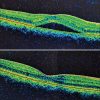Comparison of oral propranolol, oral rifampicin, and intravitreal anti-VEGF in central serous chorioretinopathy
- PMID: 37787239
- PMCID: PMC10683675
- DOI: 10.4103/IJO.IJO_169_23
Comparison of oral propranolol, oral rifampicin, and intravitreal anti-VEGF in central serous chorioretinopathy
Abstract
Purpose: To compare the efficacy of oral propranolol, oral rifampicin, and intravitreal anti-VEGF therapies on resolution-time and visual outcome in patients with central serous chorioretinopathy (CSCR).
Methods: A total of 30 patients with CSCR were randomized into three groups of 10 patients. Group A was given oral propranolol, Group B was given oral rifampicin 4 weeks each, and Group C was given 0.05 ml intravitreal injection of anti-VEGF. Comparisons of mean BCVA, contrast sensitivity, and central macular thickness (CMT) performed between baseline and follow-up at 4 weeks, 6 weeks, and 3 months.
Results: Statistically significant improvement in BCVA and contrast sensitivity was noted among all three groups. Complete resolution of SRF as indicated by CMT was seen at the end of 4 weeks in Group C, whereas there was a steady decline in CMT until 3 months in Groups A and B.
Conclusion: Intravitreal anti-VEGF therapy shows a significantly faster SRF resolution. However, oral propranolol and oral rifampicin could prove as a useful, cost-effective treatment of CSCR.
Keywords: Anti-VEGF; central serous chorioretinopathy; propranolol; rifampicin.
Conflict of interest statement
None
Figures
References
-
- Badar A, Khan S, Shah SU, Tahir M, Babree S. Comparison of oral rifampicin with observation alone in treatment of acute central serous Chorioretinopathy. International Journal of Retina. 2020;3 doi: 10.35479/ijretina.2020.vol003.iss001.103.
-
- Lim JW, Kim MU. The efficacy of intravitreal bevacizumab for idiopathic central serous chorioretinopathy. Graefe's Archive for Clinical and Experimental Ophthalmology. 2011;249:969–74. - PubMed
-
- Guengerich F. P. Cytochrome P-450 3A4: Regulation and role in drug metabolism. Annu. Rev. Pharmacol. Toxicol. 1999;39:1–17. - PubMed
Publication types
MeSH terms
Substances
LinkOut - more resources
Full Text Sources
Miscellaneous





